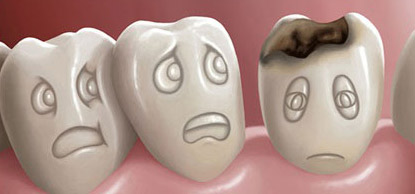CONSERVATIVE DENTAL TREATMENT (FILLING)

• Filling is the restoration of the lost material in our teeth damaged by decay by cleaning the affected area properly and restoring the tooth with appropriate materials.
What is Decay?
The bacterial plaque present in the mouth produces acids from the bacteria. These acids gradually damage the enamel layer on the tooth surface, causing decay. Although enamel is the hardest tissue in our body, acids severely harm the general structure of tooth enamel. The bacteria slowly penetrate the hard enamel over a long period, causing damage. After the enamel is damaged, the decay reaches the much softer dentin layer, then approaches the tooth pulp (the core). After some time, sensitivity to sugar, cold, and heat recurs. In some cases, decay may progress silently and chronically without causing pain. Your teeth can lose all their vitality.

What is a Healthy Filling?
• There are important details to consider when selecting the filling material. While aesthetic appearance is important, compatibility with existing tissue and durability are equally crucial. Today, there are three types of filling materials used.
Amalgam (Silver) Fillings
• Amalgam fillings, well known and used since ancient times, have a history of 150 years. They contain mercury, silver, and various metal alloys. We cannot say their protective effect is excellent. Patients who chose amalgam fillings for years often show secondary decay around these fillings. Amalgam fillings also have disadvantages. Being hard, they do not adapt well during chewing and micro-cracks are often observed.
Their grayish color is also a disadvantage aesthetically, limiting their preference. Since 2025, their use has been discontinued in Europe except for special cases.
Composite (White) Fillings
• Composite fillings have rapidly advanced in the last twenty years alongside developments in dentistry. Initially, they were considered less durable compared to amalgam fillings. Today, micro-particle technology improvements have made composite fillings stronger. Many reasons support their selection: only the decayed part needs to be cleaned for placement; no additional retention materials are needed; and aesthetically, they blend well with the tooth color. Thanks to the "chameleon effect" in modern technology, they take on the color of the surrounding tooth, making composites very attractive. This method provides excellent results especially in the front teeth.
Porcelain Fillings - Partial Fillings
• In cases where tooth substance loss is too large for simple fillings, porcelain fillings allow continuing with the original tooth appearance without full crown coverage. Porcelain fillings are preferred for decay under the gum or cases where a pin needs to be inserted into the tooth structure. These fillings, made and polished in the lab, provide patients with confident smiles after two sessions. The porcelain used is highly resistant to pressures between 2-6 tons, reducing the need for replacement fillings later.
What are Inlays and Onlays?
• During treatment of dental decay, metals or composites are used as filling materials. For large substance losses, porcelain fillings are preferred due to their aesthetic and durability advantages. After cleaning the decayed tissue, an impression is taken and the filling is prepared in the laboratory.
What are the Advantages of Inlays and Onlays?
• They are highly preferred due to their aesthetic appearance and excellent compatibility with the tooth structure.







